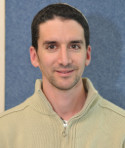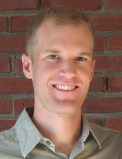
May 14, 2018
“Biological processes are dynamic; they require dynamic measurements to understand them,” says Yehuda Brody, Ph.D. Brody, a third-year post-doctoral associate in the Blainey Lab at the Broad Institute of MIT and Harvard (Cambridge, MA) who has been visually measuring single cell gene expression kinetics for several years. Now, focusing on mutagenesis process kinetics, he and his colleagues have developed a new method for DNA sequencing that allow them to analyze the flow of mutation accumulation with single cell cycle resolution. Paul Blainey, Ph.D., presented this innovative approach at SLAS2018.

Somatic mutations are constantly occurring in our bodies, from the moment we are born. Most of the time they're harmless. But over a lifetime, they add up and can be linked to many age?related diseases, including neurodegeneration, organ failure and cancer. According to Brody, scientists historically studied the effect of mutations as functional genomics, focusing on the consequences of the mutations. The field has since evolved, and people have started exploring the source of mutations viewing mutagenesis as a phenomenon: what mechanism caused the mutation in the first place and how does the cell deal with damages in the DNA. Brody says this is an important shift in thinking. “By looking at the process of mutagenesis and not just the consequences, we can focus on decreasing the number of accumulated mutations in order to prevent them and the diseases associated with them.”

One way to determine the cause of mutations is to study their patterns. Blainey believes the more precisely these patterns can be characterized, the better the chances of working backwards and figuring out the cause of the mutation. As he explains, that's a pretty complicated process: “Lesions in the DNA can occur due to several external or internal sources. For example, there might be a damaging chemical in the environment, but mutations also happen naturally. Then there's also different DNA repair machinery, which undoes some of the mutations, and evolutionary selection, which makes the different mutations more abundant or less abundant based on functional effects. Because there's so much happening that's all mixed together, it's very challenging to trace it back. It takes a really detailed analysis and a lot of understanding about all these different biological and chemical processes to try to put that picture together."
Conventional methods of single-cell genome sequencing, such as microfluidics, come with a high error rate and a high cost, inhibiting their widespread use. In 2016, Xu and colleagues published a simple, robust alternative to these complicated systems. But despite increased availability, next-generation sequencing (NGS) is not without its limitations when it comes to somatic mutation analysis.
For one thing, somatic mutations are relatively rare. According to Blainey, typical expected rates are around 10-11 to 10-8 single nucleotide polymorphism (SNP) per base pair with each cell division whereas the typical consensus error rate of regular NGS is around 10-5 SNP per base pair. Simply put, he says, NGS just isn’t accurate enough to detect somatic mutations.
Another limitation of the current methods, Brody points out, is that when we use single-cell sequencing, we don't know anything about the cell’s interactions and the timing. “Our goal was to develop a way to see when and where the mutation occurs to gain some context of the mutations and get clean quantitative and qualitative data to show where the mutation really comes from.”
The researchers explain that whole genome sequencing of single cell DNA usually happens one of two ways: either you start with one cell, so you have a copy of the genome, you amplify it, then sequence it. Or you take that cell, expand it into a colony and then sequence the colony.
Blainey says Brody’s work represents an effort to move beyond these traditional approaches to improve the quality of the data and get temporal information. He says, “it’s a so different than what other people are doing you have to look closely to even recognize it as a single cell method.”
This novel approach starts with a small population from a single founding cell that is allowed to grow for a few generations. Then single cells from the population are sampled and sub-cloned to create a group of cells that represents each lineage in the original population. DNA from the sub-clonal cells are then sequenced. “Then,” Blainey says, “when we go into the data sets to call the novel variants we take advantage of a prior estimate of the lineage relationship between the samples. Because we know the relationship between the cells, we know something of its history; we can take a specific cell and trace it back to see where and when changes happened each step along the way.” Brody likens it to a microscope to see the mutation at a specific time point with single cell-cycle resolution. “Using this tool, we can really focus on the questions of how mutations appear in the genome and how they correlate in space and time.”
Blainey believes this “lineage sequencing” is not only a fundamental tool for basic mutagenesis research but also may have practical applications. One example he gives is understanding the biology of mutations caused by exposure to carcinogens like environmental chemicals or smoking. "We're really trying to make quantitative and detailed links between those carcinogens, mutations, the biology of the cells and ultimately, way down the line, cancer." Brody hopes that with this kind of knowledge, “25 or 30 years from now we can develop therapies that decrease the rate of mutations and prevent age-related diseases like cancer.”
Another potential application Blainey finds particularly interesting is reducing the unwanted effects of DNA-damaging cancer therapies like alkylating agents, topoisomerase inhibitors and cisplatin. These drugs work by damaging the tumor cell's DNA faster than the rapidly-dividing cells can fix it, eventually killing the cell. Since normal cells aren't replicating as quickly as the tumor cells, they have fewer mutations and can tolerate the therapy more easily. Or can they? As Blainey points out, people who get this kind of therapy often end up developing secondary malignancies. "I don't think there's a very good understanding of the mutational burden that's placed on the patient's normal cells when you're applying one of these DNA-damaging therapies, partly because of the lack of tools to analyze it. I think it is important to consider the risks of that therapy for future cancers. Brody's method may offer a tool to study the mutational burden in a very detailed way.”
This method of observing mutagenesis could help in predicting who will benefit from DNA?damaging chemotherapies by applying it with genetic manipulations to see how specific genetic backgrounds react to drugs like cisplatin. According to Blainey, “If we knew better, as a function of dose, how many mutations you got with a given chemotherapy, perhaps we could find that sweet spot where you get a lot of efficacy, but you're not at the maximum number of mutations yet.”
Finding that sweet spot may require a personalized approach. Researchers at the Massachusetts Institute of Technology have shown that the ability to repair DNA varies between individuals. "Here again, our method could be beneficial in predicting that,” says Blainey.
Other fields where Brody sees potential applications include in vitro fertilization, stem cell research, other age-related diseases and environmental exposure. He is excited about future collaborations, but for now, he says, the main goal is to share their concept for this type of analysis in the hope that by understanding the utility others will become interested in applying the method themselves. “We want to show not only how to do it but demonstrate what is possible and hopefully encourage others to develop even more ways to use it.”
Blainey agrees. "Everything has to start somewhere. For technology development, you often start with an initial idea and then over a long period of time there are a lot of further improvements that really advance the performance and applicability of a new approach.” He sees platforms like SLAS as instrumental to that process. “I think the real value of meetings like SLAS is you go and you see a hundred different things and they percolate for a while. Then months or years later you make a technical connection based on something from the meeting. It’s definitely planted the seed on a hundred things like that. Our presentation was to help people understand how it can impact different application areas. We're looking forward to making other people aware of this concept, having them take what we've put together and applying their own ideas to it."
Blainey’s SLAS2018 presentation, “New Approaches for Single Cell Genome Sequencing and Mutation Analysis,” is available as an on-demand webinar (synched slides and audio) free-of-charge to SLAS members.
Automated Digital Microfluidic Sample Preparation for Next-Generation DNA Sequencing
Development of a High-Content Screening Method for Chemicals Modulating DNA Damage Response
High-Content Fluorescent-Based Assay for Screening Activators of DNA Damage Checkpoint Pathways